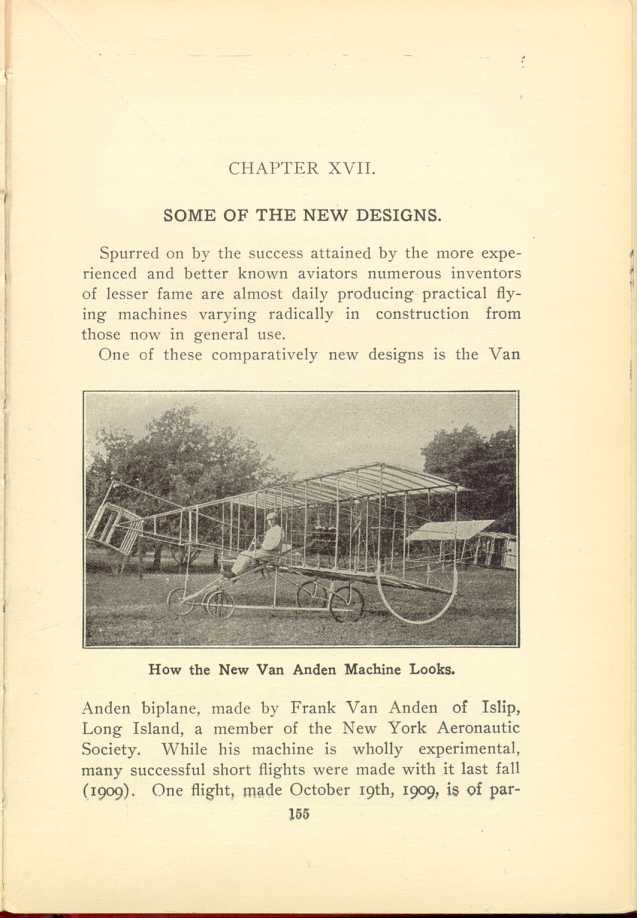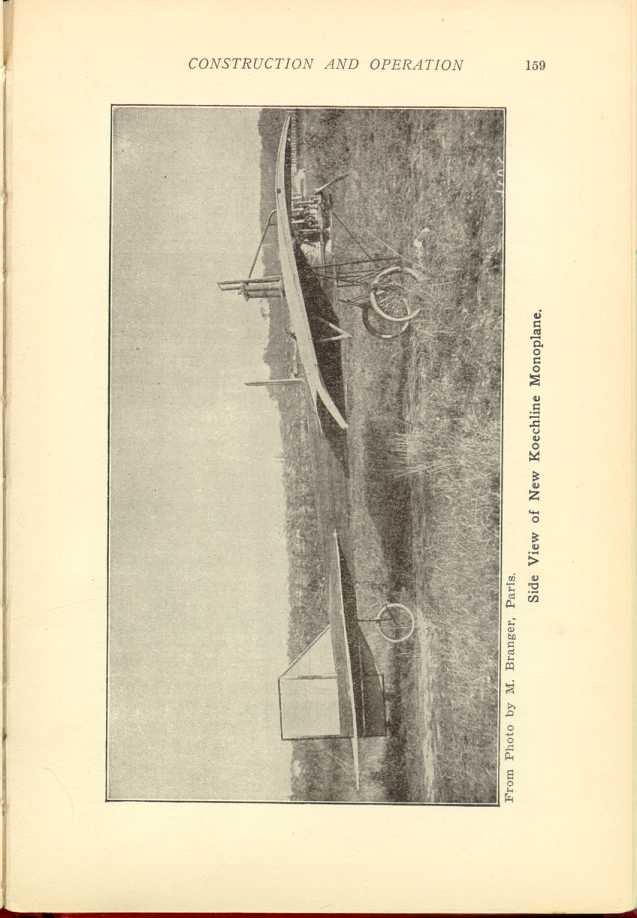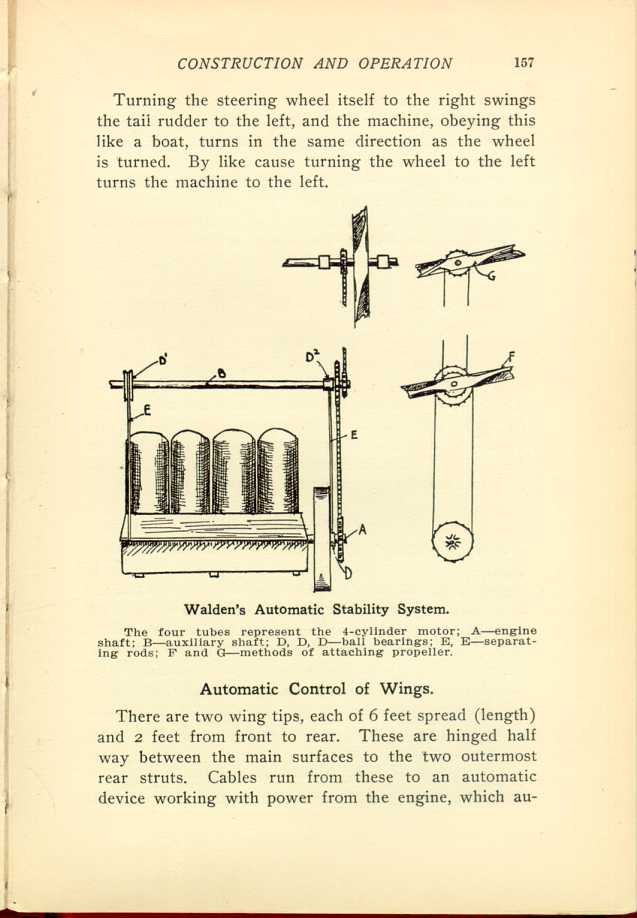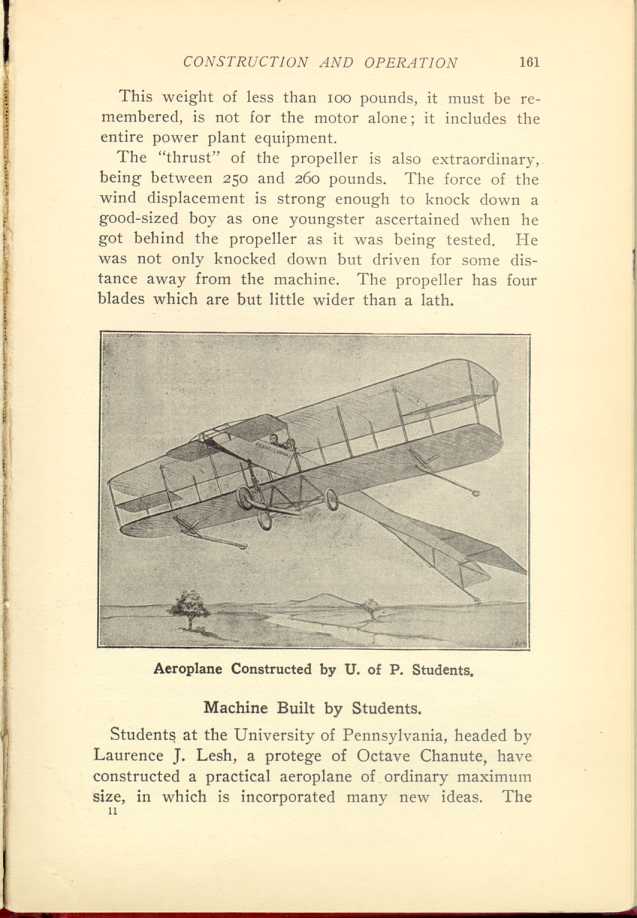17. CHAPTER XVII.
SOME OF THE NEW DESIGNS.
Spurred on by the success attained by the more experienced and better known aviators numerous inventors of lesser fame are almost daily producing practical flying machines varying radically in construction from those now in general use.
One of these comparatively new designs is the Van

How the New Van Anden Machine Looks.
[Description: Black and white photograph: Man in flying machine.]
Features of Van Anden Model.
In size the surfaces of the main biplane are 26 feet in spread, and 4 feet in depth from front to rear. The upper and lower planes are 4 feet apart. Silkolene coated with varnish is used for the coverings. Ribs (spruce) are curved one inch to the foot, the deepest part of the curve (4 inches) being one foot back from the front edge of the horizontal beam. Struts (also of spruce, as is all the framework) are elliptical in shape. The main beams are in three sections, nearly half round in form, and joined by metal sleeves.
There is a two-surface horizontal rudder, 2x2x4 feet, in front. This is pivoted at its lateral center 8 feet from the front edge of the main planes. In the rear is another two-surface horizontal rudder 2x2x2 1/2 feet, pivoted in the same manner as the front one, 15 feet from the rear edges of the main planes.
Hinged to the rear central strut of the rear rudder is a vertical rudder 2 feet high by 3 feet in length.
The Method of Control.
In the operation of these rudders—both front and rear—and the elevation and depression of the main planes, the Curtiss system is employed. Pushing the steering-wheel post outward depresses the front edges of the planes, and brings the machine downward; pulling the steering-wheel post inward elevates the front edges of the planes and causes the machine to ascend.
Turning the steering wheel itself to the right swings the tail rudder to the left, and the machine, obeying this like a boat, turns in the same direction as the wheel is turned. By like cause turning the wheel to the left turns the machine to the left.
Automatic Control of Wings.
There are two wing tips, each of 6 feet spread (length) and 2 feet from front to rear. These are hinged half way between the main surfaces to the two outermost rear struts. Cables run from these to an automatic device working with power from the engine, which automatically
It was the successful working of this device which righted the Van Anden craft when it was overturned in the squall of October 19th, 1909. Previous to that occurrence Mr. Van Anden had looked upon the device as purely experimental, and had admitted that he had grave uncertainty as to how it would operate in time of emergency. He is now quoted as being thoroughly satisfied with its practicability. It is this automatic device which gives the Van Anden machine at least one distinctively new feature.
While on this subject it will not be amiss to add that Mr. Curtiss does not look kindly on automatic control. "I would rather trust to my own action than that of a machine," he says. This is undoubtedly good logic so far as Mr. Curtiss is concerned, but all aviators are not so cool-headed and resourceful.
Motive Power of Van Anden.
A 50-horsepower "H-F" water cooled motor drives a laminated wood propeller 6 feet in diameter, with a 17 degree pitch at the extremities, increasing toward the hub. The rear end of the motor is about 6 inches back from the rear transverse beam and the engine shaft is in a direct line with the axes of the two horizontal rudders. An R. I. V. ball bearing carries the shaft at this point. Flying, the motor turns at about 800 revolutions per minute, delivering 180 pounds pull. A test of the motor running at 1,200 showed a pull of 250 pounds on the scales.
Still Another New Aeroplane.
Another new aeroplane is that produced by A. M.

From Photo by M. Branger, Paris.
Side View of New Koechline Monoplane.
[Description: Black and white photograph: monoplane from side.]
The system of rudder and elevation control is very simple. The aviator sits in front of the lower plane, and extending his arms, grasps two supports which extend down diagonally in front. On the under side of these supports just beneath his fingers are the controls which operate the vertical rudder, in the rear. Thus, if he wishes to turn to the right, he presses the control under the fingers of his right hand; if to the left, that under the fingers of his left hand. The elevating rudder is operated by the aviator's right foot, the control being placed on a foot-rest.
Motor Is Extremely Light.
Not the least notable feature of the craft is its motor. Although developing, under load, 30-horsepower, or that of an ordinary automobile, it weighs, complete, hardly 100 pounds. Having occasion to move it a little distance for inspection, Mr. Burgess picked it up and walked off with it—cylinders, pistons, crankcase and all, even the magneto, being attached. There are not many 30-horsepower engines which can be so handled. Everything about it is reduced to its lowest terms of simplicity, and hence, of weight. A single camshaft operates not only all of the inlet and exhaust valves, but the magneto and gear water pump, as well. The motor is placed directly behind the operator, and the propeller is directly mounted on the crankshaft.
This weight of less than 100 pounds, it must be remembered, is not for the motor alone; it includes the entire power plant equipment.
The "thrust" of the propeller is also extraordinary, being between 250 and 260 pounds. The force of the wind displacement is strong enough to knock down a good-sized boy as one youngster ascertained when he got behind the propeller as it was being tested. He was not only knocked down but driven for some distance away from the machine. The propeller has four blades which are but little wider than a lath.
Machine Built by Students.
Students at the University of Pennsylvania, headed by Laurence J. Lesh, a protege of Octave Chanute, have constructed a practical aeroplane of ordinary maximum size, in which is incorporated many new ideas. The
Immediately back of the aviator is an extra seat and an extra steering wheel which works in tandem style with the front wheel. By this arrangement a beginner may be easily and quickly taught to have perfect control of the machine. These tandem wheels are also handy for passengers who may wish to operate the car independently of one another, it being understood, of course, that there will be no conflict of action.
Frame Size and Engine Power.
The frame has 36 feet spread and measures 35 feet from the front edge to the end of the tail in the rear. It is equipped with two rear propellers operated by a Ramsey 8-cylinder motor of 50 horsepower, placed horizontally across the lower plane, with the crank shaft running clear through the engine.
The "Pennsylvania I" is the first two-propeller biplane chainless car, this scheme having been adopted in order to avoid the crossing of chains. The lateral control is by a new invention by Octave Chanute and Laurence J. Lesh, for which Lesh is now applying for a patent. The device was worked out before the Wright brothers' suit was begun, and is said to be superior to the Wright warping or the Curtiss ailerons. The landing device is also new in design. This aeroplane will weigh about 1,500 pounds, and will carry fuel for a flight of 150 miles, and it is expected to attain a speed of at least 45 miles an hour.
There are others, lots of them, too numerous in fact to admit of mention in a book of this size.

